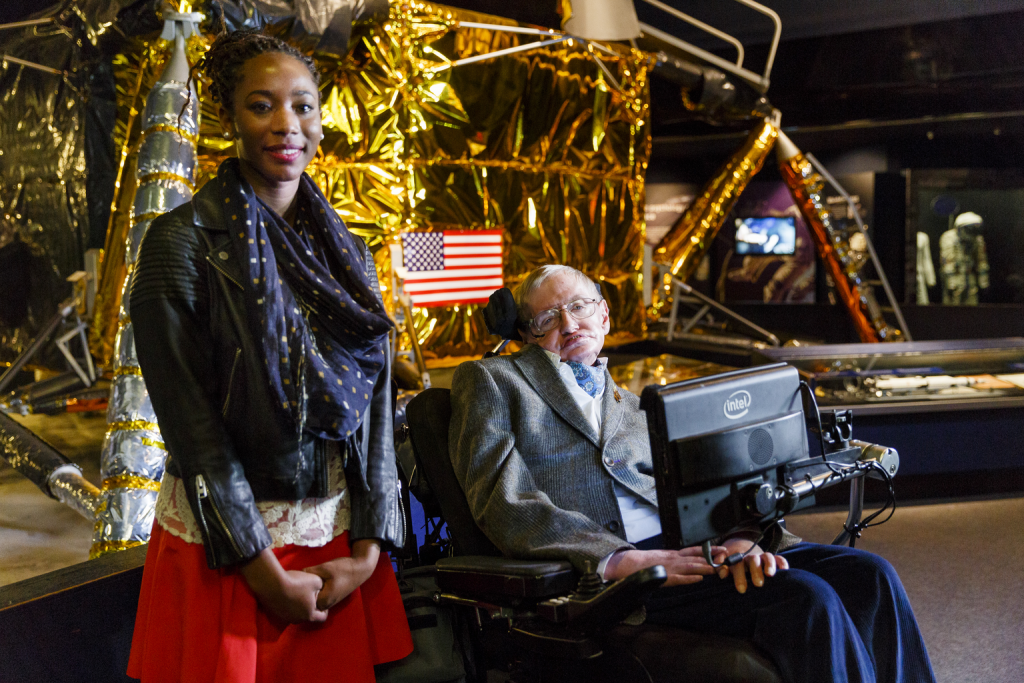This week, Professor Stephen Hawking gave London’s Guest of Honour, Adaeze Uyanwah, a personal guided tour of the Science Museum.
Describing the museum as one of his favourite places, the Cambridge University cosmologist told Adaeze “It helped fuel my fascination with physics and I have been coming here for decades.”

The tour, which lasted more than an hour, is one of a series of magic moments for Adaeze, 24, from California, who beat off over 10,000 international entrants to win a trip of a lifetime to London.
Adaeze and Professor Hawking were formally welcomed by Ian Blatchford, Director, and Dame Mary Archer, Chair of the Board of Trustees.
The tour reflected Professor Hawking’s passion for space travel, cosmology and the museum itself. In the Energy Hall, he talked about the science of thermodynamics and his prediction that black holes would emit radiation, now called Hawking radiation, which has been highly influential in fundamental physics.
In the Making the Modern World gallery, he pointed out the command module of Apollo 10, launched in May 1969 as a dress rehearsal for the first Moon landing, and in the Exploring Space gallery, a model of the Apollo 11 moon lander, telling Adaeze “it is important we continue human space exploration”.
Curator Doug Millard, who accompanied the tour alongside fellow Curators Alison Boyle and Andrew Nahum, carefully opened the Apollo 10 command module. Adaeza had the rare opportunity to peer inside the module, which carried astronauts Thomas Stafford, John Young and Eugene Cernan to within 14 kilometres of the surface of the Moon. Professor Hawking also had the opportunity to peer inside, with the help of a camera on a stick.

Professor Hawking introduced Adaeze to items from the collection that hold special significance for him, including a rare copy of Newton’s Principia Mathematica, one of the most important books in science, and an iPad portrait of him drawn for a 70th birthday exhibit in the museum by David Hockney, about which he commented: “I’m still not quite sure about the fingers.”
He also discussed his speech synthesiser, the first version of which is in the museum’s collections. “I was happy to lend my voice recently to Eddie Redmayne recently to give him a bit of a boost in his efforts to win an Oscar. Unfortunately, Eddie did not inherit my good looks.”

During the tour, which included the double helix, Adaeze asked Professor Hawking what of our common shortcomings as human beings would he alter, and what of our virtues would he magnify, if it were possible. He replied:
“The human failing I would most like to correct is aggression. It may have had survival advantage in caveman days, to get more food, territory, or partner with whom to reproduce, but now it threatens to destroy us all. A major nuclear war would be the end of civilization, and maybe the end of the human race. The quality I would most like to magnify is empathy. It brings us together in a peaceful, loving state.”
Adaeze said that Professor Hawking’s tour of the Science Museum was a once in a life time experience which would stay with her:
“It’s incredible to think that decades from now, when my grandchildren are learning Stephen Hawking’s theories in science class, I’ll be able to tell them I had a personal meeting with him and heard his views first hand. It’s something I’ll never forget and I’m so grateful to him and the Museum for this awesome experience.”
Professor Hawking, who is a fellow of the museum, has been visiting since his childhood.”When we were young, my mother used to leave me at the science museum, my sister, Mary, at the Natural History Museum, and my younger sister, Philippa, at the Victoria and Albert Museum. At the end of the day, my mother collected us all.”
Each year around one million school age children visit the museum, which plays a fundamental role in inspiring the next generation of scientists and engineers.